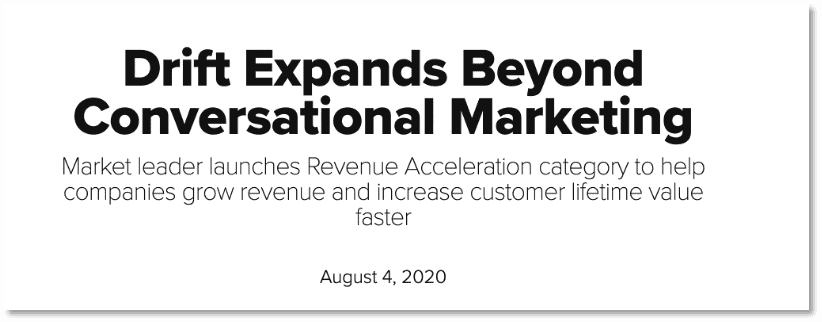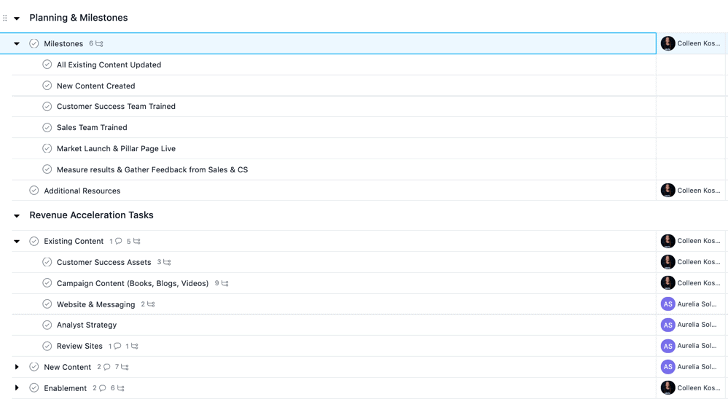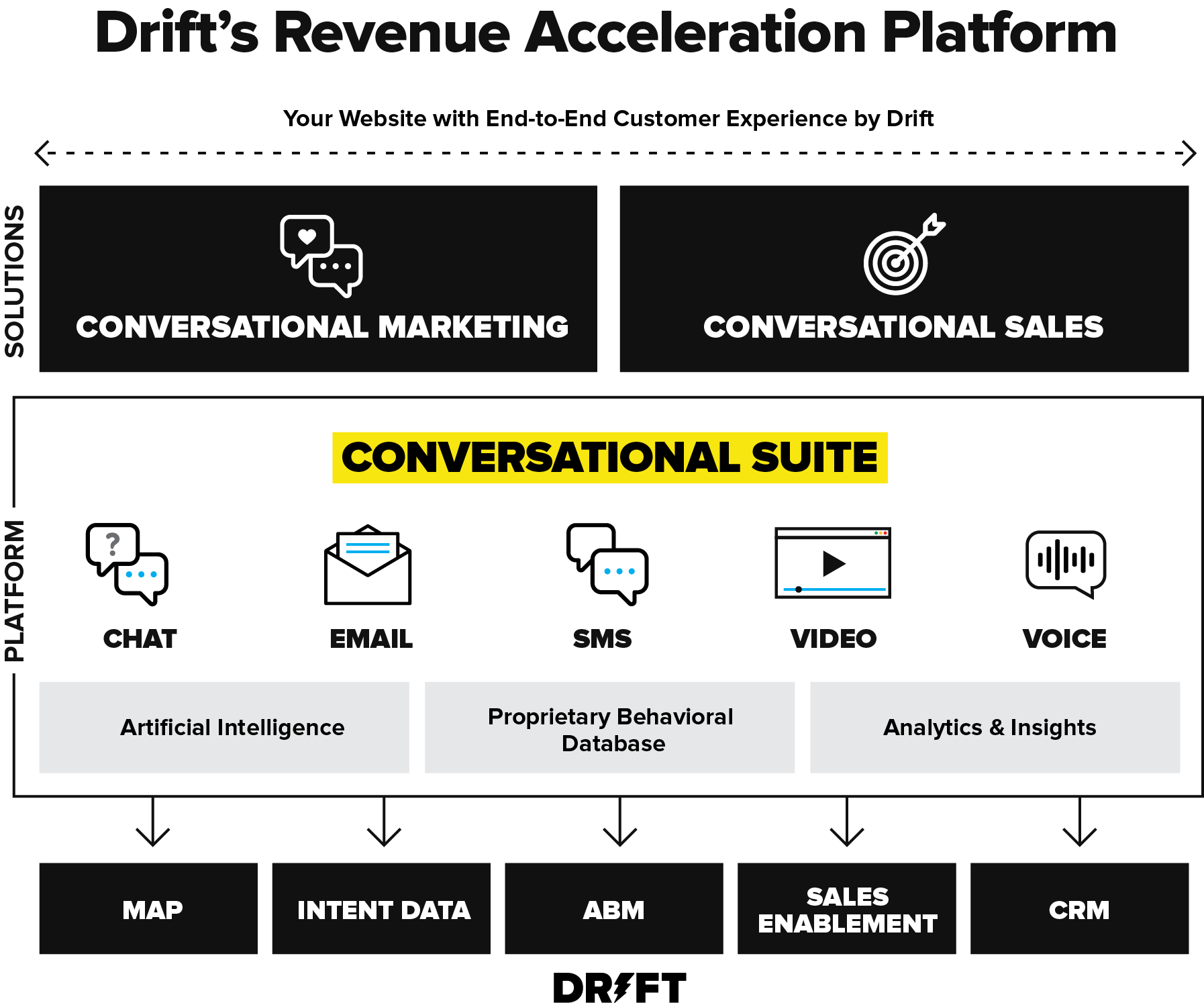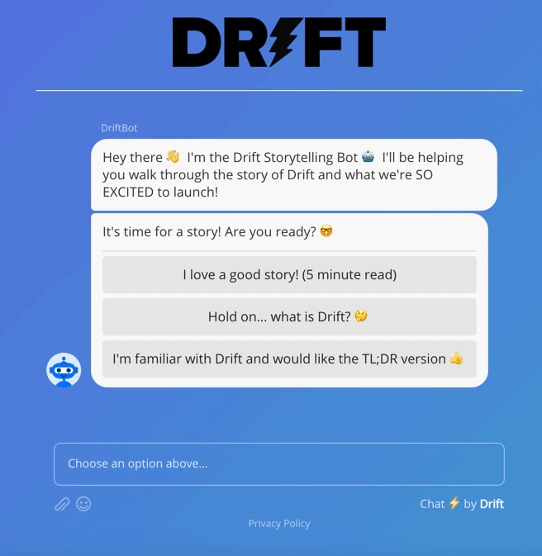On August 4th, Drift announced not only the release of Drift Prospector for sales but an entirely new category: Revenue Acceleration.
And we did it in the middle of a pandemic 👇

It’s always nerve-wracking launching a new category. That said, if there was a best time to create a category, that time is now.
Today, I’m sharing why Drift created a category during a downturn, how to launch a category with a distributed workforce, and best practices to jumpstart your own category creation.
Why Create a Category During a Downturn?
There are three main reasons why we decided to create a category during this downturn:
- Playing it safe isn’t an option: According to McKinsey, “…companies are more likely to thrive if they act aggressively to capture market share during downturns rather than wait for the recovery to begin.” There won’t be a sudden return to normalcy after COVID. That means we can’t keep viewing everything through a temporary lens. Innovation should still be a priority for your business.
- Buyers and customers need our help now: Buyers’ needs are changing rapidly. This means innovation should take priority, not a backseat. What new pains are your buyers and customers experiencing? How can your business address that market right now?
- How we go-to-market (GTM) is changing: 96% of business leaders said that COVID changed their GTM models – and that digital interactions are 2x more important to customers than they were prior to COVID. Meaning digital marketing and sales isn’t just the new normal – it’s the gold standard.
Downturns introduce new challenges and problems to the marketplace – and magnify the blemishes that were already there. The pandemic pushed companies to accelerate digital transformation by years, as organizations pivoted to meet the needs of a distributed workforce and customer base.
We didn’t have the luxury of a flashy physical conference to announce our category, but we saw a need in the marketplace. So, we took the plunge.
When we launched Revenue Acceleration, our biggest challenge was managing all the moving pieces with a virtual workforce. Here’s how we did it and how you can too (and yes, there will be spreadsheets):
How to Launch a Category with a Distributed Workforce
To spare you a laundry list of step-by-steps, in this section, I’ll focus on the key milestones to consider when launching a category virtually.
Getting Remote Project Management Right
Starting in early 2020, the Drift marketing team made the switch to integrated marketing campaigns. As part of that transition, we introduced new tools and GTM motions to streamline our work.
This prepared the team for remote project management and collaboration when we shifted to WFH in March. Using a combination of Asana and Google Sheets, our team was able to assign tasks, deadlines, and projects across the company – remotely – to get Revenue Acceleration off the ground and running.
Here’s a look at the high-level Asana project board 👇

Before we start digging into this project board, let’s talk about the “pre-work” that comes before creating any category: validating your hypothesis.
Validating Your New Narrative
If you’re creating a category, you need to do your research. You need to ensure that there’s a clear demand, potential competition (competition validates after all), and that the new category solves a customer pain.
All of this requires some pre-category launch work, including:
- Customer validation: Prior to launch we reached out to our customers’ Chief Marketing Officers (CMO) and Chief Revenue Officers (CRO). We walked them through the concept of the Revenue Acceleration Platform and how it brings together both Conversational Marketing and Conversational Sales.
- Independent market research: You should be able to answer questions like: How large is your addressable market in this category? What potential competitors fit into this category? How does this category address the current and future focus of your business?
- Analyst outreach: If you have the ability to work with analysts, use them to better frame your narrative. Companies like TOPO, Forrester, Gartner, and SiriusDecisions are the most popular consultants typically used during a sales and marketing GTM motion.
- VC insights: If you’re part of a VC-backed company, you’ll want their insight and involvement during the category creation process. Emergence Capital’s Viviana Faga joined me on my CMO Conversations podcast to share her expertise. Viviana has launched multiple categories over her seasoned career at companies including Salesforce (where we met), Jive, Yammer, Microsoft, and Zenefits. You can listen in here 👇
The Defining Event: Launching a Category with a Major Product Release
Launching a new category should be linked to one or two events:
- A product launch: A new innovation, product, or service can create a compelling event to launch a category. Especially if that innovation addresses a new audience or pain point in the marketplace.
- Or a turning point event: How has the state of your industry or market necessitated this category? 2020 is definitely an oddity. But like many downturns, it forced innovation in unexpected ways. For businesses that meant revisiting and improving digital channels – making marketing and sales platforms like Drift more necessary than ever.
Drift has multiple tier-one (major) product launches throughout the year. Our tier-one product launch for August 2020 was Drift Prospector. Because Drift Prospector opens up more opportunities for sales, it was a compelling event to introduce Revenue Acceleration as a way to unify marketing and sales’ GTM strategy 👇

But how did we prioritize content around these announcements? Let’s dive in.
Pre-Launch Work: Creating the Content to Introduce Your Category to the Market
There were a number of key content channels that we needed to tackle before our digital launch:
- Website update: You don’t need to update your entire website overnight to launch a new category. I’ve seen companies delay big announcements in order to get launches “just right.” Focus on a few important updates, like:
- New pages: Create new pages that will help explain upcoming changes. During our launch, we created dedicated pages for both Drift Prospector and Revenue Acceleration.
- Homepage: We also updated the language on our homepage and made sure links and playbooks used up-to-date terminology.
- Dedicated bot: One of my favorite features we launched for Revenue Acceleration was a “storytelling bot.” This bot is accessible via a banner CTA at the top of the Drift website. It walks visitors through the “story of Revenue Acceleration” and how it fits into the Drift narrative and the current state of marketing and sales. Also, it’s seriously cute 👇

- Enablement: Before the product launch, we had breakout sessions with each team. In these sessions, departments were trained on both our Revenue Acceleration Platform and Drift Prospector. We have a great enablement team here. They developed the content (decks, remote training, one-sheeters, boilerplate copy, video explainers, etc.) for:
-
- Sales enablement
- Customer success enablement
- Marketing/company enablement
- New hire training
- And Drift Insider courses
-
- Press and announcements: It goes without saying, but any category creation will involve press outreach. We launched two press releases to announce Revenue Acceleration and Drift Prospector. Both included quotes from customers we worked with during pre-launch. We also targeted trade outreach to influencers in sales/CRO-facing roles and martech/CMO-facing roles. Press will be ongoing post-launch, but it’s important to strategize press for launch day.
- Customer communication: From login screens to customer emails and newsletters, we made sure all customer-facing channels had relevant content to reference. Your customers should be well-informed of any new product updates and positioning changes.
Launch Day: Rallying Your Company Around a Digital Category Launch
You know Drifters love to make some noise during big launches. On the morning of a big launch, the marketing team makes a post on Slack and sends a company email encouraging employees to share their voice on social 👇

Everyone from account managers to VPs to our CEO, David Cancel, take time out of their day to share the message:
Launching a category remotely relies on creativity and legwork. In today’s marketplace, it isn’t enough for your company to post a press release and hope for the best. You need to go beyond a manicured press release and connect on a human level.
Post-Launch & Final Thoughts
I couldn’t be more excited about bringing Revenue Acceleration to the market, especially as more companies look to support new, agile GTM strategies.
Even though August 4th has come and gone, there’s still a lot of post-launch work that needs to be done. If you’re interested in learning more about what that process looks like, shoot me a message on Twitter or LinkedIn.
To end, I want to reinforce some of the recommendations I mentioned before:
- Get remote project management right first: Even before WFH started, the marketing team was laying the groundwork for integrated campaigns in Asana. This made it much easier to project plan the launch of Revenue Acceleration as a remote team. Determine the system that works for your team, define your goals, and then go all in.
- Don’t try to do everything at once: You don’t need to completely overhaul your website for a category launch. Instead, focus on the content you need now and the channels easily accessible to buyers and customers. Prioritize less pressing updates in the weeks and months that follow.
- Keep your customers in the loop: Take your competitors by surprise – not your customers. Have a strong customer communication plan for your category launch. In addition, be sure to involve customers during the category creation process. Take their feedback seriously and use their social proof (with permission) to promote during a launch.
- Internal enablement is everything: Your category needs its own GTM strategy. That means arming your customer-facing teams with the knowledge and content to confidently talk about this new narrative.
- Get employees involved: I sound like a broken record, but your employees are your best brand advocates. Their networks and influence are just as important as any press syndication. Get them involved and operationalize the process so it’s easier to rally the troops on big launch days.
Category creation is a defining moment in any marketer’s career. I hope this article is a valuable resource when your time comes!







